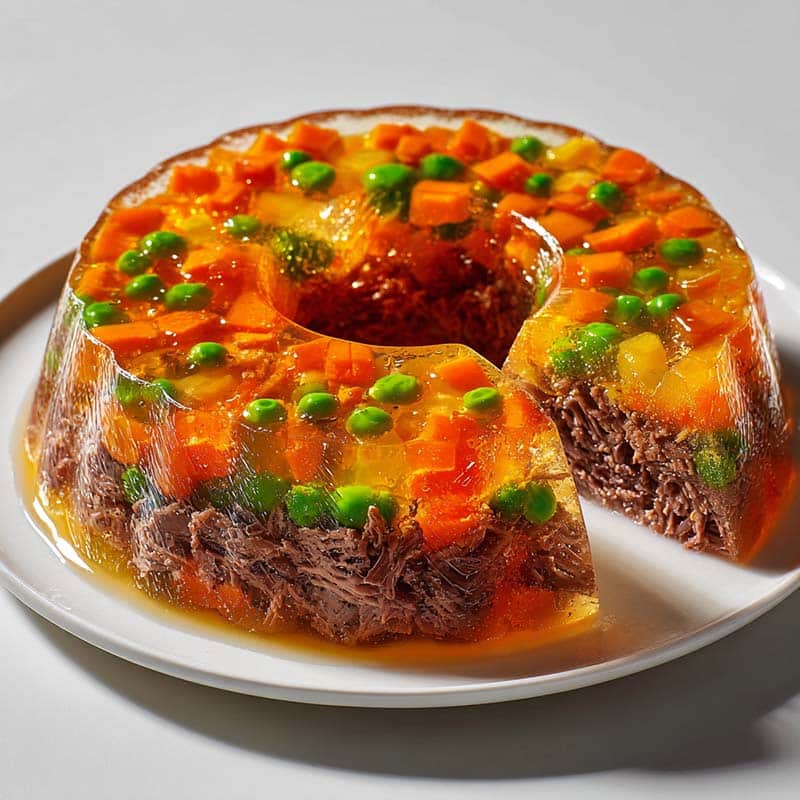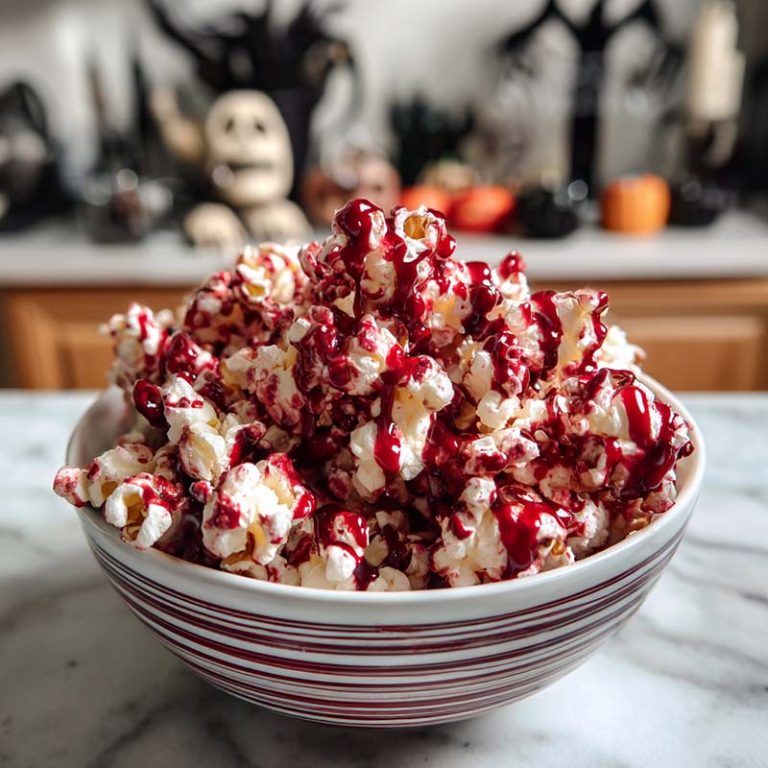“Jello with meat” might raise some eyebrows today, but this unique dish has deep culinary roots. Combining gelatin with savory meats like ham, chicken, or beef was once a show-stopping centerpiece at gatherings. In this article, we’ll explore the origin and resurgence of meat in Jell-O dishes, plus share how to make a clean, high-protein version that aligns with today’s wellness-focused lifestyle. Whether you’re curious, nostalgic, or adventurous, you’ll discover why this odd-sounding dish actually packs serious flavor and nutrition. We’ll also answer your top questions and offer a step-by-step guide to creating your own savory gelatin creation.
Table of Contents
Jello with Meat in Culinary History
The retro charm of meat jelly
I remember my grandmother serving a wiggly dome of aspic layered with roast beef slices at every holiday. It glistened under the dining room lights, surrounded by olives, carrots, and parsley. As a kid, I was skeptical meat in jello? But one bite, and I was hooked. That savory gelatin had soaked up the broth’s richness, and the tender beef gave it body. Back then, “jello with meat” wasn’t a gag it was gourmet. From Eastern European aspics to mid-century American meat molds, this dish held a place of honor on the table.
Today, this nostalgic recipe is being revisited with a healthier spin. Using high-protein broth, lean meats, and clean gelatin, you can create a dish that’s both elegant and packed with nutrients. Plus, it’s an eye-catching addition to any gathering. The keyword “jello with meat” may sound quirky, but its value lies in versatility use it as a protein-rich snack, party appetizer, or meal-prep option. In fact, when made right, this savory jello can offer as much protein as a classic chicken salad.
Why meat in gelatin made sense
Historically, people used gelatin to preserve and elevate meats. Before refrigeration, sealing cooked meats in a gelatin-rich broth (aspic) kept bacteria out and texture in. It also made humble cuts luxurious. Fast-forward to the 1950s in the U.S., and savory jello dishes made with boxed flavored gelatin—became a canvas for creativity. Think tuna suspended in lemon Jell-O or ham in lime gelatin. While some combinations were questionable, others like chicken in tomato aspic were genuinely delicious.
Now, the clean eating movement revives this dish with real stock-based gelatin, pasture-raised meats, and vegetables. It’s part tradition, part trend and completely protein-packed.
For another retro favorite turned healthy, check out our keto carnivore pizza muffins or these flavorful cheddar-stuffed bbq bacon bombs.
Print
Jello With Meat – Shocking Comeback Of A Forgotten Protein Classic
- Prep Time: 10 minutes
- Cook Time: 5 minutes
- Total Time: 6 hours
- Yield: 4 servings
- Category: Appetizer
- Method: No-bake, Chill
- Cuisine: American
Description
A nostalgic, protein-packed savory jello recipe made with flavorful broth, tender meat, and vibrant herbs perfect for wellness-conscious women looking for a fun, retro twist on high-protein meals.
Ingredients
- 2 cups beef or chicken broth
- 2 tbsp unflavored gelatin
- 1 ½ cups cooked shredded meat (chicken, ham, or beef)
- ½ tsp garlic powder
- ¼ tsp black pepper
- Salt to taste
- ½ cup cooked carrots or peas (optional)
- Fresh parsley for garnish
Instructions
1. Bloom gelatin in ½ cup cold broth for 5 minutes.
2. Heat remaining broth until steaming.
3. Stir bloomed gelatin into hot broth until fully dissolved.
4. Layer meat and veggies into loaf pan or ramekins.
5. Pour gelatin mixture gently over the solids.
6. Refrigerate 4–6 hours until fully set.
7. Unmold and garnish with parsley. Serve chilled.
Notes
For extra tang, add 1 tsp apple cider vinegar to the broth.
Use grass-fed gelatin for a cleaner, more nutritious result.
Great as a make-ahead appetizer or light lunch.
Nutrition
- Serving Size: 1 portion
- Calories: 180
- Sugar: 1g
- Sodium: 340mg
- Fat: 9g
- Saturated Fat: 3g
- Unsaturated Fat: 6g
- Trans Fat: 0g
- Carbohydrates: 3g
- Fiber: 0g
- Protein: 18g
- Cholesterol: 55mg
How to Make Savory Jell-O with Meat
Ingredients that work for savory gelatin dishes
If you’re wondering how to make savory Jell-O, it all begins with high-quality gelatin. Forget the fruit-flavored packets savory jello needs unflavored gelatin and a deeply flavorful liquid base. I use grass-fed beef broth or homemade chicken stock for maximum collagen and nutrients. For the meat, cooked shredded chicken, slow-braised beef, or even deli ham works well. Add-ins like diced vegetables, herbs, and even boiled eggs can make it visually stunning and texturally balanced.
Here’s a basic structure for savory jello with meat:
- Liquid base: 2 cups of hot, flavorful broth (beef, chicken, or veggie)
- Gelatin: 2 envelopes (about 2 tbsp) unflavored gelatin
- Protein: 1 to 1½ cups chopped cooked meat
- Flavor builders: garlic powder, onion powder, salt, pepper, fresh herbs
- Optional add-ins: peas, carrots, hard-boiled egg slices, olives
This combination gives you a protein-rich, savory treat that’s surprisingly satisfying and shelf-stable for days. The keyword “jello with meat” might still raise eyebrows, but with the right ingredients, you’ll change minds fast.
Step-by-step process for a perfect set
Making meat in jelly is simpler than it sounds. First, sprinkle the gelatin over ½ cup of cold broth to “bloom” for 5 minutes. Meanwhile, heat the rest of the broth until steaming (not boiling). Stir in the bloomed gelatin until fully dissolved. Next, layer your cooked meats and optional veggies into a loaf pan or individual ramekins. Carefully pour the broth mixture over the solids and refrigerate for 4–6 hours until set.
Once firm, unmold your savory jello and garnish with parsley or a dollop of mustard. You’ll be amazed by how beautifully the meat suspends in the gelatin. Plus, it’s a feast of textures smooth, tender, and rich.
Pair this savory jello with our refreshing garlic butter salmon with spinach or serve as a starter before a classic creamy smothered chicken over rice.
Is Meat Jell-O Good? Nutrition and Taste Reimagined
The surprising nutrition in jello with meat
Let’s set the record straight: when made with real ingredients, jello with meat can be incredibly nutritious. It’s high in protein, rich in collagen, and low in processed additives. Unlike sugary desserts, savory jell-O offers hydration, amino acids, and healthy fats all essential for muscle repair, skin health, and gut function. The gelatin itself provides glycine and proline, which support joints and digestion.
For fitness-minded women like me, it’s a clever snack or appetizer that fits perfectly into a high-protein, clean eating lifestyle. I often use leftover chicken and homemade broth, turning simple scraps into something elegant and satisfying. A serving can deliver around 15–20 grams of protein for less than 200 calories.
But does it actually taste good?
The taste of meat jell-O depends entirely on the base. If you use high-quality broth and seasoned meat, the flavor is deeply savory like a cold version of your favorite stew. The gelatin simply carries and intensifies those flavors while giving it that fun texture. It’s smooth, melts in your mouth, and lets the herbs, meat, and aromatics shine.
Still, not everyone’s a fan. Texture can be off-putting if it’s too rubbery, and cold meat isn’t for everyone. But with the right balance of salt, acid (a splash of vinegar or lemon), and fresh herbs, savory gelatin can be a showstopper. And in warm months, it’s a smart, no-cook alternative to heavy casseroles or fried snacks.
For more nutrient-rich creations, check out these crispy cheddar corn potato fritters or our comforting melted mozzarella and ranch chicken bombs.
Does Jell-O Have Meat in It? Gelatin Origins & Clean Alternatives
Understanding gelatin: what’s really in your jello?
One of the most common questions I get is, “Does Jell-O have meat in it?” Technically, yes at least in the form of gelatin, which is derived from animal collagen. Commercial gelatin is made by boiling animal bones, skin, and connective tissues (usually from cows or pigs) to extract collagen, which is then dehydrated into powder. So while there are no meat chunks in a typical Jell-O dessert, it’s not vegetarian or vegan.
That’s why “jello with meat” isn’t as strange as it sounds. Gelatin is meat-based at its core. The difference is, savory versions embrace the meat flavor rather than masking it with fruit and sugar.
Clean gelatin choices for your recipes
If you’re like me and care about sourcing, opt for grass-fed, pasture-raised gelatin. It’s richer in nutrients, has a purer taste, and supports animal welfare. Look for brands like Great Lakes or Vital Proteins for the best results in both savory and sweet recipes.
For plant-based readers, you can try agar-agar, a seaweed-based gelatin alternative. It sets firmer than traditional gelatin and works beautifully in savory molds. However, the mouthfeel is different more brittle than silky. Still, it opens up the world of savory jellies to vegetarians and vegans who want to experiment with textures and presentation.
Whether you’re using traditional gelatin or alternatives, the key is to balance flavor, protein, and texture. “Jello with meat” might sound old-school or even bizarre but in today’s world of clean eating and protein-forward meals, it’s surprisingly relevant.
( Want to keep experimenting? Don’t miss our turkey stuffing balls or get inspired by this chinese ground beef and cabbage stir-fry for more protein-rich ideas.
FAQ About Jello with Meat
What is meat in jelly called?
Meat in jelly is traditionally known as aspic. Originating in Europe, aspic refers to savory gelatin dishes made by boiling meat stock until it forms a jelly-like texture. It’s often used to encase meats, vegetables, or eggs for preservation and presentation. Today, it’s being revived with modern flavors and clean ingredients.
Is meat Jell-O good?
Yes when made with flavorful broth, quality meat, and proper seasoning, meat Jell-O (or savory jello) can be surprisingly delicious. It’s rich, protein-packed, and offers a silky texture that enhances the flavor of the meat. It’s especially great for meal prepping or cold appetizers in warmer months.
How to make savory Jell-O?
Start by blooming unflavored gelatin in cold broth, then dissolve it in hot broth. Add cooked, seasoned meat and optional vegetables to a mold. Pour in the gelatin broth mixture, refrigerate for 4–6 hours, and serve chilled. Use homemade stock for deeper flavor and clean ingredients.
Does Jell-O have meat in it?
While Jell-O brand products don’t contain visible meat, they do contain gelatin, which is derived from animal collagen (usually pork or beef). That means Jell-O is not vegetarian. For plant-based versions, use agar-agar instead of traditional gelatin.
Conclusion
“Jello with meat” might seem like a vintage oddity, but it’s a high-protein, flavorful dish worth revisiting. Whether you’re looking to impress with a retro appetizer, boost your protein intake with a clean snack, or explore culinary nostalgia, savory jello is surprisingly versatile. With a little creativity and quality ingredients, you can transform this quirky classic into a wellness-friendly favorite.
Want more inspiration for clean, protein-rich dishes that fuel your goals? Follow me on Facebook @ProteinMealsDaily and discover daily high-protein ideas on Pinterest @JoudiaDeROSA. Let’s bring flavor and strength to every plate!








